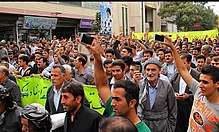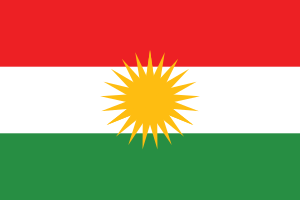Kurds in Iran
Kurds in Iran (Kurdish: Kurdên Îranê ,کورد لە ئێران,[6] Persian: کردها در ایران)[7] are the third largest ethnic group in Iran[8] after Persians and Iranian Azerbaijanis, comprising about 10% of the country's population according to the CIA in 2014.[1]
| Total population | |
|---|---|
| 8.1 million (10%) (2014 CIA estimate)[1] | |
| Languages | |
| Kurdish, Gorani and Persian | |
| Religion | |
| Shia Islam (Twelver)[2][3] Sunni Islam (Shafi‘i)[4] (Sufi order Qadiriyya also present)[5] Yarsanism | |
| Related ethnic groups | |
| see Iranian peoples |
Geographic distribution

Iranian Kurdistan or Eastern Kurdistan (Kurdish: Rojhilatê Kurdistanê), is an unofficial name for the parts of western Iran inhabited by Kurds which borders Iraq and Turkey.[9] It includes the Kurdistan Province, Kermanshah Province, West Azerbaijan Province, Ilam Province, Lorestan Province and West Azerbaijan Province.[10][11][12][13]
Shia Feyli Kurds inhabit Kermanshah Province, except for those parts where people are Jaff, and Ilam Province; as well as some parts of Kurdistan and Hamadan provinces. The Kurds of Khorasan, in the North Khorasan Province of northeastern Iran, are Shi'ite Muslims.[14][15] The Laki tribe populate parts of Ilam Province and Lorestan Province, while Chegini Kurds reside in central Lorestan.
During the Iranian Revolution, Kurdish nationalist political parties were unsuccessful in attracting support, who at that time had no interest in autonomy.[16][17] However, since the 1990s, Kurdish nationalism in the region has grown, partly due to outrage at the government's violent suppression of Kurdish activism.[18]
Religion
The two major religions among Kurds in Iran are Islam and Yarsanism, while fewer Kurds adhere to Baháʼí and Judaism.[19][20] There is disagreement on which is the largest denomination among Kurds; some experts such as Richard N. Frye and Martin van Bruinessen argue that Sunni Islam (the Shafi‘i branch[4]) is the majority religion,[21][22] while researcher Anu Leinonen believes it is the Twelver branch of Shia Islam.[23]
Pockets of Sunni Kurds belong to the Qadiriyya tariqa (around Marivan and Sanandaj). These orders have experienced repression from the state, including the destruction of their places of worship.[5][24] Yarsanis are also targeted by the central government.[25]
Separatism
Kurdish separatism in Iran[26][27][28] is weaker than Kurdish separatism in the other parts of Kurdistan, possibly because of the stronger cultural links between Kurds and Persians. Even so, there has been sporadic separatist conflict[26] since 1918, most recently during the 2016 West Iran clashes.[27] Today, some of the main protagonists are the Kurdistan Free Life Party, the Democratic Party of Iranian Kurdistan, and the Komala Party of Iranian Kurdistan.
Tribes
| Tribe | Kurdish and Persian names | Geography | Notes |
|---|---|---|---|
| Beiranvand | Kurdish: Bîranwend ,بیرانوەند Persian: بیرانوند | Between Aleshtar and Khorramabad; Bayranshahr.[29] | Laki–speaking.[29] |
| Chegini | Kurdish: Çengînî ,چەگینی Persian: چگنی | Between Khorramabad and the Kashgan river.[30] | Chegini dialect (Mixture of Laki and Luri)[31] |
| Dilfan | Kurdish: Dilfan ,دیلفان Persian: دلفان | Around Delfan County. Present in Ilam and Mazandaran provinces as well.[32] | Laki–speaking.[32] |
| Donboli | Kurdish: Dimilî ,دونبەلی Persian: دنبلی | Khoy and Salmas area.[33] | Turkophone[34] |
| Feyli | Kurdish: Feylî ,فهیلی Persian: فیلی | Ilam Province (Ilam, Chardoval, Mehran, Malekshahi, Abdanan, Dehloran).[35] | Southern Kurdish–speaking.[35] |
| Guran | Kurdish: Goran ,گۆران Persian: گوران | Hawraman region. | Gorani–speaking.[36] |
| Hasanvand | Kurdish: حەسەنوەند Persian: حسنوند | Around Aligudarz, Khorramabad and Borujerd.[37] | Laki–speaking.[38] |
| Herki | Kurdish: Herkî ,ھەرکی Persian: هرکی | Western countryside of Urmia in the Targavar and Margavar valleys.[39][40] | Kurmanji–speaking.[41] |
| Jaff | Kurdish: Caf ,جاف Persian: جاف | From Sanandaj to Kermanshah with Javanrud as area of origin.[42] | Sorani–speaking.[43] |
| Jalali | Kurdish: Celalî ,جەلالیان Persian: جلالی | Around Maku.[44] | Kurmanji–speaking.[45] |
| Jalilavand | Kurdish: Celalwend ,جەلیلوەند Persian: جلیلوند | Around Dinavar and in Lorestan Province.[46] | Laki–speaking.[46] |
| Kakavand | Kurdish: Kakewend ,کاکەوەن Persian: کاکاوند | Kermanshah, Harsin area,[47] and Kakavand District, Delfan.[48] | Laki–speaking.[47] |
| Kalhori | Kurdish: Kelhûr ,کەڵھوڕ Persian: کلهر | Around Eslamabad-e Gharb, Qasr-e Shirin and Gilan-e Gharb.[49] Ilam Province (Chardoval and Eyvan)[35] | Southern Kurdish–speaking.[35] |
| Mamash | Kurdish: Mamaş ,مامش Persian: مامش | Southern parts of West Azerbaijan.[50] | Sorani–speaking.[50] |
| Mangur | Kurdish: Mangûr ,مەنگوڕ Persian: منگور | Around Piranshahr, Mahabad, Sardasht and Bukan in West Azerbaijan.[51] | Sorani–speaking.[52] |
| Milan | Kurdish: Mîlan ,میلان Persian: میلان | North of Zurabad in northern West Azerbaijan[53] | Kurmanji–speaking.[53] |
| Mukri | Kurdish: Mukrî ,موکری Persian: مکری | Around Baneh, Mahabad, Piranshahr and Saqqez.[54] | Sorani–speaking.[55] |
| Sanjâbi | Kurdish: Sencabî ,سنجاوی Persian: سنجابی | Western parts of Kermanshah Province.[56] | Southern Kurdish-speaking.[57] |
| Shekak | Kurdish: Şikak ,شکاک Persian: شکاک | Western countryside of Urmia.[58] | Kurmanji–speaking.[59] |
| Zangana | Kurdish: Zengine ,زەنگەنە Persian: زنگنه | South of Kermanshah.[49] | Southern Kurdish–speaking.[49] |
References
- "The Time of the Kurds". CFR. Retrieved 22 April 2020.
- Leinonen, Anu (2017). Unity or Diversity? Turkish Nationalism, Kurds, and the Turkish Mainstream Press (PDF). Helsinki: University of Helsinki. p. 66. ISBN 978-951-51-2890-4.
Most Iranian Kurds are Shi’a (of Twelver Shi’ism).
- Sebastian Maisel (2018). The Kurds: An Encyclopedia of Life, Culture, and Society. p. 54.
- Ali Ezzatyar (2016). The Last Mufti of Iranian Kurdistan: Ethnic and Religious Implications in the Greater Middle East. p. 29. ISBN 9781137563248.
- "Dervish practice Sufism on a yearly, 30-day journey through Kurdistan". Rûdaw. 27 February 2019. Retrieved 22 April 2020.
- "خوێندکارانی کورد لە ئێران". zheen.org (in Kurdish). Retrieved 22 April 2020.
- محمّدعلی چلونگر; کیومرث عظیمی (2012). "پراکندگی فرق و مذاهب تشیّع در کردستان". shiitestudies.com (in Persian). 10 (39). Retrieved 22 April 2020.
- Political Geography of Iranian Nationalities farsnews.com 18 February 2018
- Kurdish Awakening: Nation Building in a Fragmented Homeland, (2014), by Ofra Bengio, University of Texas Press
- Federal Research Division, 2004, Iran: A Country Study, Kessinger Publishing, ISBN 1-4191-2670-9, ISBN 978-1-4191-2670-3, p. 121, "The Kurdish area of Iran includes most of West Azerbaijan."
- Youssef Courbage, Emmanuel Todd, 2011, A Convergence of Civilizations: The Transformation of Muslim Societies Around the World, p. 74. Columbia University Press, ISBN 0-231-15002-4, ISBN 978-0-231-15002-6. "Kurds are also a majority of the population in the provinces of Kermanshah, West Azerbaijan, and Ilam."
- William Eagleton, 1988, An Introduction to Kurdish Rugs and Other Weavings, University of California, Scorpion, 144 pages. ISBN 0-905906-50-0, ISBN 978-0-905906-50-8. "Iranian Kurdistan is relatively narrow where it touches the Soviet border in the north and is hemmed in on the east by the Azerbaijani Turks. Extending south along the border west of Lake Urmia is the tribal territory."
- http://www.pen-kurd.org/kurdi/ikrambalekani/eyaletakurdistane-liirane.html
- "http://rangvarehayeyekrang.ir". Archived from the original on 2017-12-17. Retrieved 2017-08-12. External link in
|title=(help) - "عشایر کرد خراسان؛ گردشگری عشایری" (in Persian). 29 October 2016. Retrieved 22 April 2020.
- Romano, David (2006). The Kurdish Nationalist Movement. New York: Cambridge University Press. p. 235. ISBN 0-521-85041-X.
- McDowall (1996). A Modern History of the Kurds. London: I.B. Tauris. p. 270. ISBN 1-85043-653-3.
- McDowall (1996). A Modern History of the Kurds. London: I.B. Tauris. p. 278. ISBN 1-85043-653-3.
- Helen Chapin Metz (1989). Iran: a country study. Federal Research Division. p. 126.
- Vahid Rashidvash (August 2013). "Iranian People: Iranian Ethnic Groups" (PDF). International Journal of Humanities and Social Science. Yerevan: 221. Retrieved 24 April 2020.
- R. N. Frye. "Iran v. Peoples of Iran". Iranica Online. Retrieved 24 April 2020.
- Martin Van Bruinessen (1991). "Religion in Kurdistan". Kurdish Times. Istanbul: The Isis Press. 4: 8. doi:10.31826/9781463229887-003.
- Anu Leinonen (2017). "Unity or Diversity? Turkish Nationalism, Kurds, and the Turkish Mainstream Press". Helsinki: 66. ISBN 978-951-51-2890-4. Retrieved 24 April 2020. Cite journal requires
|journal=(help) - "Iran's Sufis Under Pressure". RadioFreeEurope/RadioLiberty. 26 February 2009. Retrieved 24 April 2020.
- "Yarsan under attack in Iran". Kurdistan24. 8 March 2016. Retrieved 24 April 2020.
- Habeeb, William Mark; Frankel, Rafael D.; Al-Oraibi, Mina (2012). The Middle East in Turmoil: Conflict, Revolution, and Change. Santa Barbara: Greenwood Publishing Group. p. 46. ISBN 978-0-313-33914-1. OCLC 753913763.
- Smith, Benjamin, "The Kurds of Iran: Opportunistic and Failed Resistance, 1918‐", Land and Rebellion: Kurdish Separatism in Comparative Perspective (PDF), Cornell, p. 10, archived from the original (PDF) on 2012-06-15
- Elling, Rasmus Christian (2013). Minorities in Iran: Nationalism and Ethnicity after Khomeini. New York: Palgrave Macmillan. p. 312. ISBN 978-0-230-11584-2. OCLC 714725127.
- Soraya Kornokar; Zarife Kazemi (2016). "مبارزات ایالت لرستان در برابر سیاستهای ضد ایلی رضاشاه با تکیه بر ایل بیرانوند" (PDF). پژوهشنامه تاریخهای محلی ایران (in Persian): 160 (۱۶۰). Retrieved 25 April 2020.
- Oberling (1990). "Cegini". Iranica Online. Retrieved 23 April 2020.
- دائرة المعارف بزرگ اسلامى (in Persian). 3. 1978. p. 373. ISBN 9789647025041.
- "دلفان". Encyclopedia of the World of Islam (in Persian). Retrieved 25 April 2020.
- John R. Perry (2015). Karim Khan Zand: A History of Iran, 1747-1779. University of Chicago Press. p. 91. ISBN 9780226661025.
- Dawud; Oberling. "Donboli". Iranica Online. Retrieved 23 April 2020.
- Mohammad Aliakbari, Mojtaba Gheitasi, Erik Anonby (September 2014). "On Language Distribution in Ilam Province, Iran". Iranian Studies. 48 (6): 3 & 7. doi:10.1080/00210862.2014.913423. Retrieved 25 May 2019.CS1 maint: multiple names: authors list (link)
- Oberling. "Guran". Iranica Online. Retrieved 23 April 2020.
- "سیمای عشایر استان لرستان" (PDF) (in Persian). تهیه وتنظیم : اداره مطالعات وبرنامه ریزی: 3. Retrieved 26 April 2020. Cite journal requires
|journal=(help) - حمیدرضا دالوند. "حسنوند". Great Islamic Encyclopedia (in Persian). 20: 1. Retrieved 26 April 2020.
- Koohi-Kamali (2003). The Political Development of the Kurds in Iran: Pastoral Nationalism. p. 34. ISBN 9780230535725.
- Borhanedin A. Yassin (1995). Vision Or Reality?: The Kurds in the Policy of the Great Powers, 1941-1947. Lund University Press. p. 72. ISBN 9780862383893.
- "Natural Language Studies". Phonetics Laboratory. 22: 11. 1976.
- "جاف". Great Islamic Encyclopedia (in Persian). 17: 6358. Retrieved 27 April 2020.
- "جاف ها و ریشه های مردمانش" (in Persian). Noryaw. 26 February 2017. Retrieved 27 April 2020.
- "Jalali". iranicaonline.org. Iranica Online. Retrieved 23 April 2020.
- J. Sheyholislami (2011). Kurdish Identity, Discourse, and New Media. Springer. ISBN 9780230119307. Retrieved 23 April 2020.
- Oberling. "Jalilavand". Iranica Online. Retrieved 25 April 2020.
- Mohammad Reza [Faribors] Hamzeh’ee (2015). "Lak Tribe". Iranica Online. Retrieved 23 April 2020.
- "Kakavand". iranicaonline.org. Iranica Online. Retrieved 23 April 2020.
- Borjian (2017). "Kermanshah vii. languages". Iranica Online. Retrieved 23 April 2020.
- غلامعلي شاملو. "با هم ميهنان خود آشنا شويم - ايل مامش" (in Persian). 1 (7): 21–25. Retrieved 29 April 2020. Cite journal requires
|journal=(help) - "(منگور (ایل" (in Persian). Portal.nlai.ir/. Retrieved 28 April 2020.
- Nashrīyah-ʼi Dānishkadah-ʼi Adabīyāt va ʻUlūm-i Insānī (15) (in Persian). Dānishgāh-i Tabrīz. Dānishkadah-ʼi Adabīyāt va ʻUlūm-i Insānī. p. 24. Retrieved 28 April 2020.
- Bagher Hoseinpour (2017). "Conflict dynamics in communal pastoral lands: a case study in Milan in north-west region of Iran" (PDF). Retrieved 25 April 2020. Cite journal requires
|journal=(help) - Oskar Mann (1906). "Die Mundart der Mukri-Kurden" (PDF) (in German). 1. Berlin: Verlag Georg Reimer: xviii–xix. Retrieved 23 April 2020. Cite journal requires
|journal=(help) - Michael L. Chyet (1991). 'And a Thornbush Sprang Up Between Them': Studies on 'Mem U Zin', a Kurdish Romance. p. 29.
- رحمتی, محسن; نظری, پیرحسین (23 August 2015). "ایل سنجابی و سیاستهای انگلیس در غرب ایران در جنگ جهانی اول" (PDF). پژوهشهای علوم تاریخی (in Persian). 7 (1): 21–39. doi:10.22059/jhss.2015.57831. ISSN 2251-9254. Retrieved 24 April 2020.
- Vahid Ranjbar Chaghakaboudi (2019). "تفاوتهای کردی کرمانشاهی و کلهری" (in Persian and Kurdish). Retrieved 24 April 2020. Cite journal requires
|journal=(help) - انزلى، حسن (2005). اورميه در گذر زمان (in Persian). p. 411.
- Sebastian Maisel (2018). The Kurds: An Encyclopedia of Life, Culture, and Society. p. 236.
